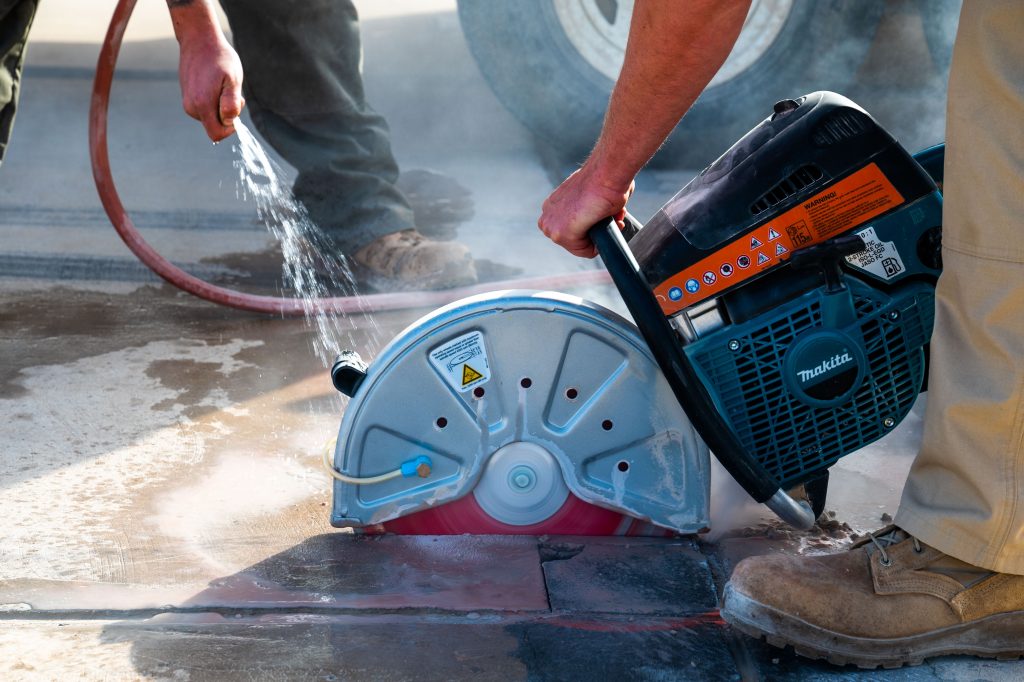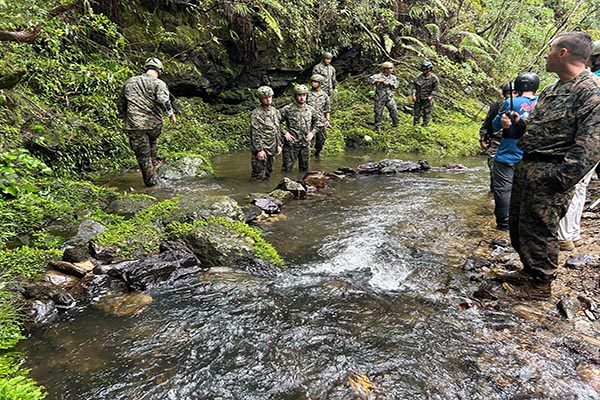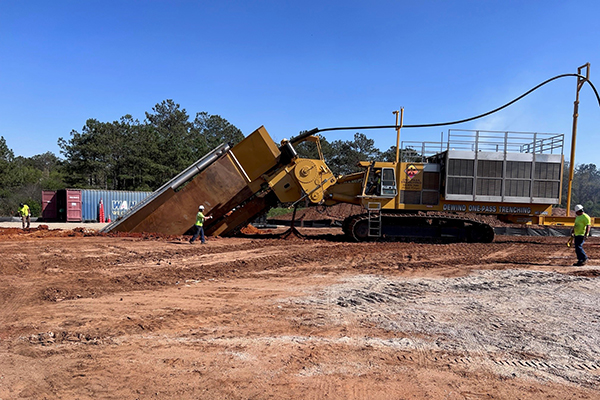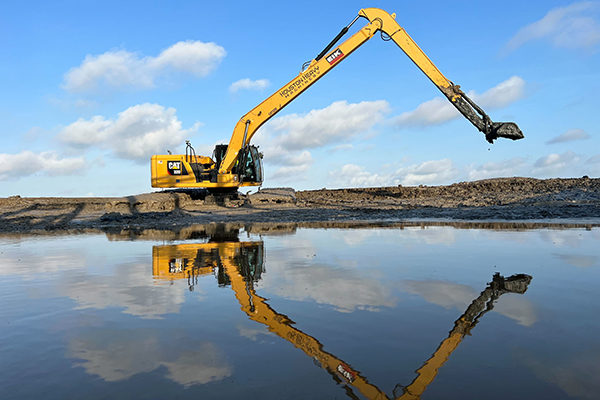By Senior Airman Tyler De Tata, USAF, and Maj. Derick Chandler, PMP, M.SAME, USAF
The risk of crystalline silica exposure is prevalent in operations associated with concrete and asphalt cutting (including runway repair), but improvements in engineering controls and personal protections can lower risks to personnel.
Crystalline silica is present in many construction applications, including sand, concrete, stone, and mortar. The substance is well-known to be dangerous as small particles when it becomes airborne. When construction workers cut or break up asphalt and concrete, these particles become suspended in air. After enough exposure to this compound, patients can develop a medical condition known as silicosis, where silica particulates damage the lung and cause scarring. It can also harm the mucous membrane. In addition, other conditions such as lung cancer, chronic obstructive pulmonary disease, and various autoimmune diseases have been observed in workers who have been exposed to crystalline silica.

as the wet method or vacuum dust collection. U.S. Air Force photo by Staff Sgt. Chris Sommers, 332rd Air Expeditionary Wing
Research from the American College of Rheumatology reviewed over 435,000 medical records from the Veterans Affairs Health Care System to better understand the effects of crystalline silica on specific military occupations. It was shown that silica dust exposures increased prevalence of rheumatoid arthritis by 10 percent and some autoimmune diseases by up to 23 percent.
This evidence shows that crystalline silica in certain military occupations is an occupational and environmental risk factor that increases medical complications and conditions.
Mitigating Exposure
Within the U.S. Air Force, several occupations generate crystalline silica on a continuous basis. The airmen most exposed to crystalline silica are usually assigned to the Horizontal Construction Section of Civil Engineering. These personnel—the “Dirt Boys”—are exposed to crystalline silica when performing processes of cutting or jackhammering concrete and asphalt during road or runway repairs.
When it comes to protecting these airmen from crystalline silica, there are three levels of prevention controls to consider: Administrative, Personal Protection Equipment, and Engineering. Engineering controls are the most valued approach.
The Occupational, Safety & Health Administration (OSHA) currently approves two engineering controls for crystalline silica: the wet method and Vacuum Dust Collection System (VDCS).
Wet Method. This method consists of applying water to the area of asphalt or concrete where cutting or jackhammering is taking place. The water saturates the silica dust particles, preventing them from becoming airborne and causing uptake into the lungs.
The wet method only controls exposure if the water is being continuously applied to the work area throughout the process. If water is applied only before the process starts, the asphalt and concrete will still be dry enough to produce respirable dust particles. Additionally, if the process is being conducted with a handheld saw, the wet method must be applied through a built-in water supply system on the saw.
Vacuum Collection. In cases where the wet method is not a realistic solution due to the situation or constraints on the project, VDCS, a vacuum-like device, can be used to lessen crystalline silica particles. However, it must be ensured that the volumetric flow rate of air suction meets the manufacturer’s standards for proper system usage. Also, the operator of the VDCS needs to operate the machine effectively.
The system operator needs to keep the inlet of the VDCS near the site of particle generation while ensuring that the hose is not being obstructed by any debris. Next, the vacuum bag must be changed frequently. Then, there needs to be a personnel changeout schedule for manning the vacuum hose and conducting the construction operations. While not overly strenuous, it would become very physically demanding to work the collection system for periods longer than four hours, which frequently is the case. Finally, the process should be paused momentarily while vacuum bags are being switched out.
It is important to note that when performing concrete repairs or other processes generating crystalline silica exposure, OSHA requires workers to wear a respirator. The agency mandates a mask with an assigned protection factor of 10 to provide adequate coverage during prolonged operations in conjunction with engineering controls. For example, a 3M 7500 half-face respirator can provide adequate protection when silica is being controlled by the wet method or VCDS. When both engineering controls are gone, the half-face does not protect the worker and the only acceptable respiratory protection would be a self-contained breathing apparatus.
Protecting Health
It is imperative that decision-makers be aware of the health dangers crystalline silica presents to workers, especially in construction operations. Military leaders should ensure that proper engineering controls are available to prevent unnecessary exposure, which could lead to loss man-hours and money through compensation claims.
Both wet method and VCDS are standard examples of how occupational health professionals, by properly implementing and utilizing engineering controls, can mitigate the health risks to servicemembers associated with crystalline silica.
Limiting Exposure
The effects of not properly using engineering controls for crystalline silica can be seen vividly through air sampling data collected during routine exposure. A case study performed in May 2023 by the Bioenvironmental Engineering Flight at Joint Base Andrews, Md., showcases a clear example of engineering control importance. The unit conducted air sampling for crystalline silica while the “Dirt Boys” with the 316th Civil Engineer Squadron were demolishing a walking path in preparation to lay a newer pathway. The processes the airmen were executing involved cutting concrete and breaking it up with a jackhammer.
During the construction project, no engineering controls were used throughout the operation. The Bioenvironmental Engineering Flight did observe that the Dirt Boys had engineering controls with them, but had failed to utilize any in the process. A total of three members were initially sampled for this study using no method of control; after results were returned, two members who were heavily involved with the cutting operation were noted to be over the OSHA-occupational exposure limit, which is 0.05-mg/m³. Of those two members, one was 11 times over the limit.
Seeing these results caused the Bioenvironmental Engineering Flight to schedule additional sampling to determine proper control recommendations and exposure profiles. The next sampling event occurred in July 2023 where the Horizontal Construction Section with the 316th performed asphalt breakup on the flightline. During this event, a VDCS was utilized. The system was a SCHWARZE A7 Tornado, which is a piece of equipment like a street sweeper with a vacuum hose attachment. The sampling results from this event were significantly under the occupational exposure limit (0.0027-mg/m³ and 0.0014-mg/m³). This indicates how important engineering controls are to controlling silica exposures.
Senior Airman Tyler De Tata, USAF, is Bioenvironmental Engineering Technician, and Maj. Derick Chandler, PMP, M.SAME, USAF, is Bioenvironmental Engineering Flight Commander, Joint Base Andrews, Md. They can be reached at officialtylerdetata@gmail.com; and dnchan19@gmail.com.
More News from TME
-

Deploying Renewable Generation Through Small-Scale Hydropower
A field demonstration and ongoing investigation of modular hydrokinetic turbines by the U.S. Army Engineer Research & Development Center’s Construction Engineering Research Laboratory illustrates the potential applicability for using the technology on military deployments. -

Rethinking Traditional Treatment Systems for PFAS Remediation
At two U.S. Air Force bases impacted by historical releases of aqueous film-forming foam, innovative methods in treating PFAS in both surface water and groundwater provide examples of success in safeguarding health for military personnel and nearby communities. -

Tackling Restoration Projects With Amphibious Excavators
When faced with soft and wet underfoot conditions, such as at a recent channel dewatering, excavation, and repair project for USACE Galveston District, amphibious excavators offer a scalable way to contour difficult site characteristics.